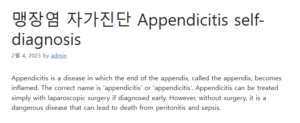Appendicitis is a disease in which the end of the appendix, called the appendix, becomes inflamed. The correct name is ‘appendicitis’ or ‘appendicitis’. Appendicitis can be treated simply with laparoscopic surgery if diagnosed early. However, without surgery, it is a dangerous disease that can lead to death from peritonitis and sepsis.

Acute appendicitis requires treatment within 48 hours. If appendicitis worsens and perforation occurs or develops into acute peritonitis, open abdominal surgery and long-term antibiotic treatment are required. So today, we will learn about the early symptoms, causes, and self-diagnosis of appendicitis. 맹장염 자가진단
appendicitis causes
Appendicitis is caused by a blockage of the hole in the appendix. The appendix is a long, thin tube. When one part is blocked, the remaining part is completely closed, and bacteria proliferate in it, and secretions secreted from the mucosal layer cannot escape, causing the appendix to expand. 좋은뉴스
The most common cause of blockage of the appendix is overgrowth of lymphoid tissue around the appendix. It mainly occurs in the 10s to 20s when the amount of lymphatic tissue increases to the maximum. Next, hard stools flow into the appendix, or foreign objects such as hair or apple seeds are the cause.
early symptoms of appendicitis
① Epigastric pain: In the early stages of appendicitis, epigastric discomfort and pain appear vaguely. Epigastric pain gradually moves to the right lower abdomen within 8 to 12 hours.
② Pain in the right lower abdomen: The location of appendicitis that we commonly know is near the ‘right lower abdomen’. However, depending on the location of the appendix, pain may occur in the right side, in the pelvis, in the upper part of the pubic bone.
③ Fever and chills: Fever appears as an inflammatory disease, and you can feel chills at the same time. In addition, some patients may experience symptoms such as nausea, vomiting, constipation, and diarrhea.
Appendicitis self-diagnosis
If you have a reflex pain when you press the painful right lower abdominal part with your hand and take it off, you can suspect acute appendicitis. Also, if the pain decreases when you bend your right knee and the pain becomes severe when you straighten your knee, it is likely appendicitis. During appendicitis, muscle stiffness appears in the right lower abdomen, and a lump may be palpable due to the formation of an abscess.
The diagnosis of appendicitis in the hospital is based on the patient’s symptoms, examination, and white blood cell count. Acute inflammatory disease results in an increased white blood cell count in a blood test. Ultrasonography is useful if the appendix is enlarged or has ruptured and become inflamed. In addition, depending on the patient’s condition, blood tests, urine tests, and CT tests are performed to diagnose.
Unlike other diseases, there is no specific treatment for appendicitis. Therefore, if you have any suspicious symptoms, you should get a diagnosis quickly. Common abdominal pain relieves symptoms over time, but appendicitis is characterized by worsening pain over time. If it is different from the abdominal pain you have felt in the meantime, or if the pain between your navel and pelvis gradually increases, you should be tested to see if it is appendicitis.